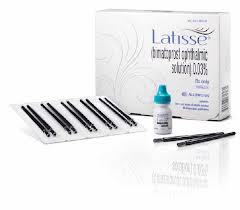As one ages, many bodily functions slow down and may even fail to function. Hair, like all bodily structures, is likewise so affected as many men and women can attest. The hair of the eyelashes is not immune to the aging process and many women can speak to their experiences with thinner and less long eyelashes that are more brittle and fall out easier now that they are older. Regardless of age, some women have naturally ‘weak’ eyelashes that are thin and sparse in number even when they are young. Both eyelash conditions as known as hypotrichosis of the eyelashes.

While Latisse is known to make eyelashes long and thicker by clinical studies which have shown 30% lengthening and 30% thickness after a few months of use), how does that translate to patient satisfaction? Many patients ask me if Latisse really works and if it is worth spending the money to use it. In other words, does it make a very visible difference in the appearance of one;s upper eyelashes?
In the July 2013 issue of Aesthetic Surgery Journal, an article was published entitled ‘Patient Reported Outcomes of Bimatoprost for Eyelash Growth – Results from a Randomized, Double Masked, Vehicle-Controlled, Parallel-Group Study’ that addressed this very question. This study was based on 278 patients who answered an Eyelash Satisfaction Questionnaire which specifically assessed not only observable eyelash growth but also overall satisfaction and perception of attractiveness and confidence. The study showed that after 4 months of use, the Latisse group had much greater improvements on all assessments than in the vehicle (non-Bimatprost) group.
These study results support the effectiveness of Latisse at producing more prominent eyelashes in adult women. All doctors who provide Latisse know this as I have yet to have a patient tell me that it did not work. Some women have to discontinue its use because of a low incidence of irritation and some patients may stop it or have never used it because of cost. But there is no question about that fact that Latisse produces visible eyelash improvement that patients perceive as worth it.
Dr. Barry Eppley
Indianapolis, Indiana


